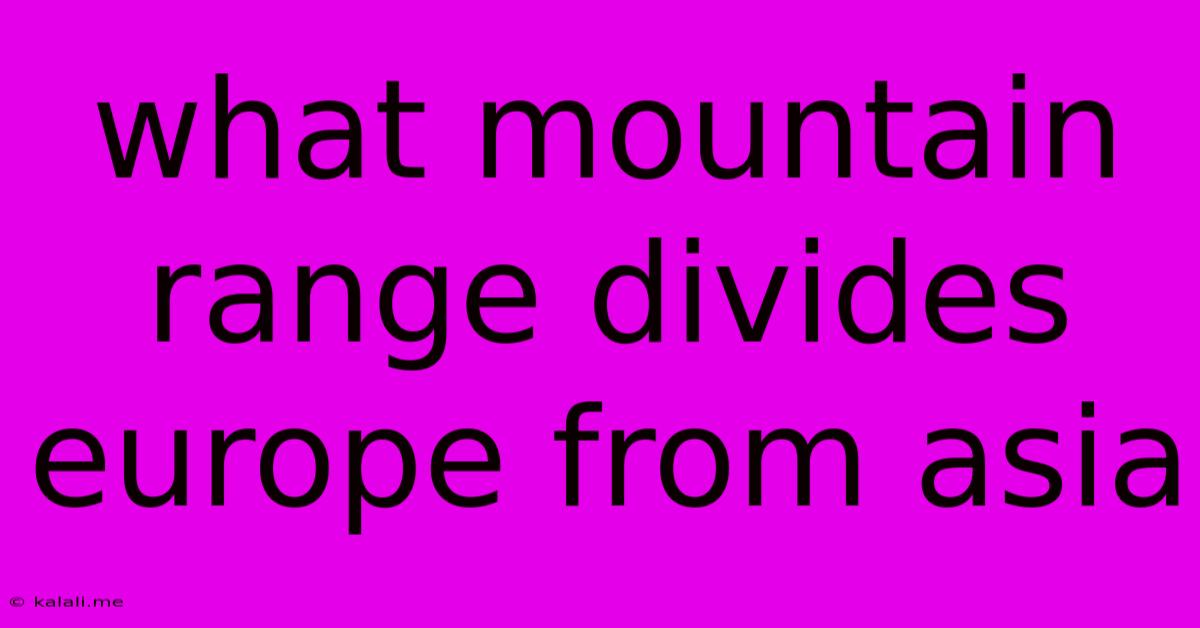What Mountain Range Divides Europe From Asia
Kalali
Jun 14, 2025 · 3 min read

Table of Contents
What Mountain Range Divides Europe from Asia? The Ural Mountains and More
The question of what mountain range divides Europe from Asia is deceptively simple. While the Ural Mountains are the most commonly cited answer, the boundary is not a neatly defined geographical line, but rather a complex and debated topic involving various geographical features. This article will explore the Ural Mountains' role as the primary divider, and discuss the other geographical features often considered part of the Europe-Asia boundary.
Meta Description: Discover the complex geographical boundary between Europe and Asia. Learn about the Ural Mountains' role, and other defining features like the Ural River, the Caucasus Mountains, and the Caspian Sea, often debated as part of the continental divide.
The Ural Mountains, stretching roughly 1,500 miles (2,400 kilometers) from the Arctic Ocean to the Kazakhstan steppes, are generally considered the primary physical feature dividing Europe and Asia. This massive mountain range serves as a significant natural boundary, separating distinct geological and ecological regions. Its relatively straightforward north-south orientation makes it a convenient, albeit somewhat arbitrary, demarcation line.
However, the simplicity ends there. The Ural Mountains alone don't fully encapsulate the intricate boundary. Several other geographical features are often included in the broader discussion, highlighting the fluid and historically nuanced nature of the continental divide.
Beyond the Urals: Other Defining Features of the Europe-Asia Boundary
-
The Ural River: This river flows south from the Ural Mountains, further extending the natural boundary to the south. It provides a relatively clear hydrological delineation between the two continents.
-
The Caucasus Mountains: Located further south, the Caucasus Mountains form a significant mountain range separating the Black Sea and the Caspian Sea. These mountains represent a strong geographical and cultural divide, with many arguing they also represent part of the Europe-Asia boundary, although their location east of the Ural Mountains makes this geographically less straightforward. The Caucasus region is often considered a geopolitical bridge between the continents, rather than firmly belonging to one.
-
The Caspian Sea: This enormous inland sea is often considered a part of the boundary, adding a significant watery element to the already complex division. Its location east of the Caucasus Mountains makes it a critical geographical landmark in the greater discussion of the Europe-Asia divide.
-
The Kuma-Manych Depression: A low-lying area running from the Sea of Azov to the Caspian Sea, this depression serves as a less distinct boundary but is often included in the discussions surrounding the continental division.
The Political and Cultural Nuances
It is crucial to understand that the Europe-Asia boundary is not merely a geographical one. Political and cultural factors have also historically played a significant role in defining where one continent ends and the other begins. Countries and regions straddling the boundary, such as Russia and Kazakhstan, often have cultural and historical ties to both continents, blurring the lines even further.
The Arbitrary Nature of Continental Boundaries
Ultimately, the question of what divides Europe from Asia doesn't have one single, universally accepted answer. The Ural Mountains provide a convenient, primarily physical, dividing line, but the reality is far more nuanced and involves a complex interplay of geographical features, political boundaries, and historical perspectives. The boundary is, in many ways, a largely arbitrary construct, reflecting the ongoing challenge of defining and classifying the world's continents.
This complexity underscores the dynamic and often contested nature of geographical boundaries, revealing that simple answers rarely suffice when dealing with such large-scale geographical features. The discussion surrounding the Europe-Asia boundary offers a fascinating case study in the challenges of classifying continents and navigating complex geographical realities.
Latest Posts
Latest Posts
-
Which Country Borders The Most Nations Mongolia Germany Brazil Luxembourg
Jun 15, 2025
-
During A Chemical Reaction The Number Of Atoms
Jun 15, 2025
-
Which Of The Following Is A Push Factor
Jun 15, 2025
-
Greatest Common Factor Of 64 And 96
Jun 15, 2025
-
Which Feature Defines A Neutral Atom
Jun 15, 2025
Related Post
Thank you for visiting our website which covers about What Mountain Range Divides Europe From Asia . We hope the information provided has been useful to you. Feel free to contact us if you have any questions or need further assistance. See you next time and don't miss to bookmark.